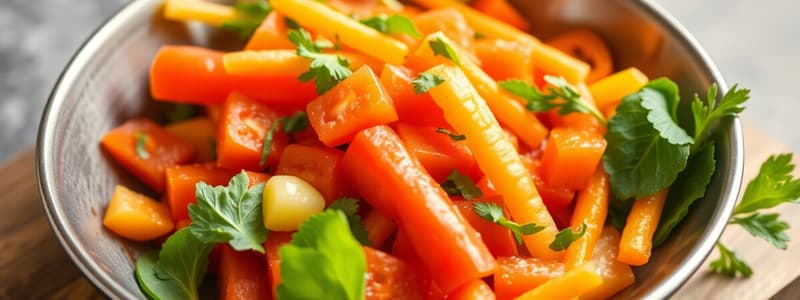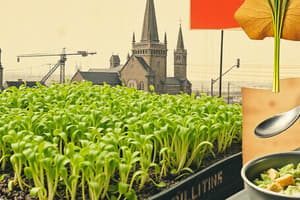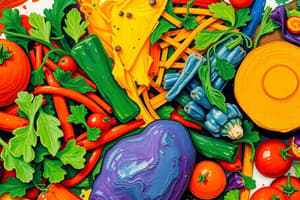Podcast
Questions and Answers
Which part of the vegetable classification does not include legumes?
Which part of the vegetable classification does not include legumes?
- Root and Tubers
- Seed Vegetables
- Fruit Vegetables
- Leafy Vegetables (correct)
Which cooking method is least likely to preserve the nutrients in vegetables?
Which cooking method is least likely to preserve the nutrients in vegetables?
- Steaming
- Blanching
- Boiling (correct)
- Sautéing
What is the primary purpose of washing vegetables before preparation?
What is the primary purpose of washing vegetables before preparation?
- To minimize enzymatic browning
- To retain water-soluble vitamins
- To enhance flavor
- To remove dirt and pesticides (correct)
Which cutting technique involves creating thin strips resembling matchsticks?
Which cutting technique involves creating thin strips resembling matchsticks?
What is a characteristic of oily fish?
What is a characteristic of oily fish?
Which vegetable cutting technique involves shredding leafy vegetables?
Which vegetable cutting technique involves shredding leafy vegetables?
Which method is best for gently cooking vegetables while retaining nutrients?
Which method is best for gently cooking vegetables while retaining nutrients?
What defines a fruit vegetable in the context of plant classification?
What defines a fruit vegetable in the context of plant classification?
Flashcards
Vegetable Classifications
Vegetable Classifications
Vegetables are categorized by their edible parts (roots, stems, leaves, etc.) and include leafy, seed, roots/tubers, fruit, stems/bulbs, and flower vegetables.
Preparing Vegetables - Minimize loss
Preparing Vegetables - Minimize loss
To preserve nutrients, minimize light and air exposure during washing, cooking, and storage and cook vegetables with skins on and until just tender.
Vegetable Cutting Techniques
Vegetable Cutting Techniques
Cutting techniques include slicing, julienne, brunoise, chiffonade, crushing, jardiniere, macedoine, mincing, paysanne, and roll-cutting, each producing specific shapes for different uses.
Vegetable Cooking Methods
Vegetable Cooking Methods
Signup and view all the flashcards
White Fish
White Fish
Signup and view all the flashcards
Oily Fish
Oily Fish
Signup and view all the flashcards
Seafood
Seafood
Signup and view all the flashcards
Steaming Vegetables
Steaming Vegetables
Signup and view all the flashcards
Study Notes
Vegetables
- Edible parts include roots, tubers, bulbs, stems, leaves, flowers, seeds, and legumes.
- Vegetables can be cooked or raw.
- Leafy vegetables are rich in vitamins A, B, and C.
- Seed vegetables include legumes like peas and beans.
- Roots and tubers are underground storage systems.
- Fruit vegetables are botanically fruits but are treated as vegetables.
- Stems and bulbs have short stems with fleshy leaves.
- Avoid nutrient loss by minimizing exposure to light and air.
- Wash vegetables but do not soak them to retain water-soluble vitamins.
- Cook vegetables with their skins on when possible.
- Cook until just tender to preserve nutrients, colors, and flavors.
- Minimize enzymatic browning by only cutting vegetables when ready.
Vegetable Cutting Techniques
- Mincing: finely divided uniform pieces.
- Paysanne: roughly chopped pieces with no specific size or shape.
- Roll-cutting: used for long fruits like zucchini and carrots.
- Slicing: cutting into thin slices.
- Julienne: matchstick cuts.
- Brunoise: small dice.
- Chiffonade: shredding leafy vegetables.
- Crushing: using a flat surface against a large blade.
- Jardiniere: cutting vegetables into thick sticks.
- Macedoine: large dice used in soups.
Methods of Cooking Vegetables
- Steaming: tenderizes without nutrient loss.
- Boiling: may result in nutrient loss if overdone.
- Roasting: caramelizes vegetables for sweetness and enhanced flavor.
- Grilling/broiling: uses dry heat from above.
- Sautéing: quick cooking with minimal nutrient loss.
- Braising: combines steaming and boiling.
- Baking: uses dry heat in an oven.
- Blanching: brief boiling with salt, followed by cooling with ice water to stop cooking.
Seafood
- Seafood are edible marine animals.
- Classifications:
- White Fish: Flattened, e.g., Flounder (dapa/tatampal); Round Fish: Round body, e.g., Milkfish (bangus), Mackerel (galunggong); Boneless Fish: Cartilaginous skeleton, e.g., Sharks.
- Oily Fish: High in omega-3, Vitamins A & D.
- Shellfish: Crustaceans(e.g., Shrimp, Crabs, (alimango, alimasag, talangka), Lobsters, Crayfish); Mollusks (e.g., Abalone, Oysters, Mussels, Squid, Octopus).
Nutritional Value of Seafood
- Rich in Vitamins A, B, D, Omega-3 fatty acids, potassium, iron, calcium, and phosphorus.
Characteristics of Fresh Seafood
- Fish: Firm flesh, clear eyes, rich red gills, seawater odor.
- Mollusks: Closed shells that open when cooked, hard and well-cupped shells.
Methods of Cooking Seafood
- Baking: Ideal for large, fatty fish.
- Grilling/Barbecuing: Suitable for small whole fish.
- Deep Frying: Battered or breaded seafood.
- Shallow Frying: Quick cooking of small pieces.
- Stir Frying: Enhances natural flavors.
- Steaming: Gentle method for shellfish.
- Simmering/Boiling: Avoid overcooking.
Studying That Suits You
Use AI to generate personalized quizzes and flashcards to suit your learning preferences.




